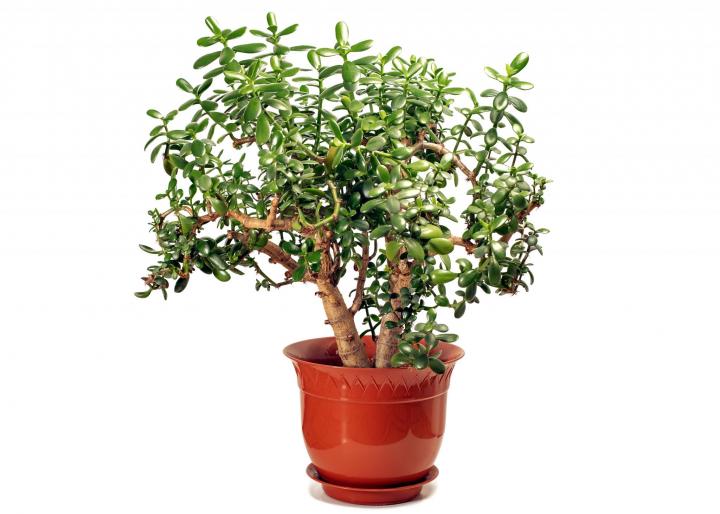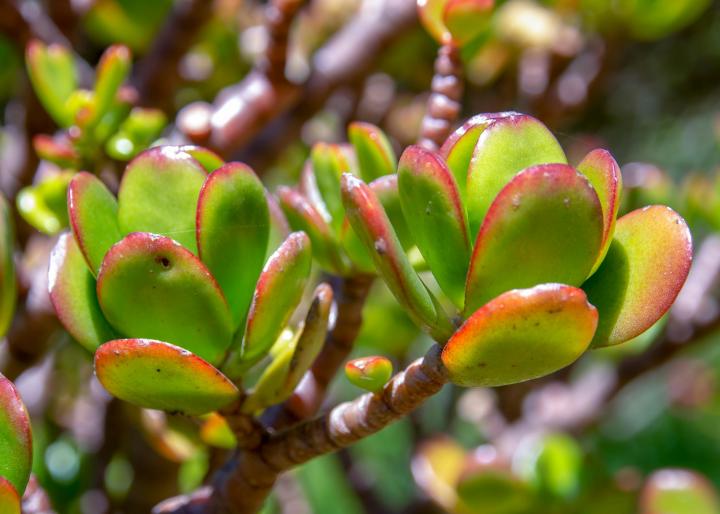
Jade can make a great houseplant, especially in a classic ceramic or terracotta pot.
Sign up for our daily newsletter to get gardening tips and advice.
Growing Jade Plants: Lighting, Watering, Repotting, Propogation, and Pests
ADVERTISEMENT
I started my jade plant from leaves of my friend's plant which her cats destroyed. It was growing quite well, but now there are many small gnat like bugs all over the soil. Could these be coming from the potting soil I used? If not, what could be their source and how can I get rid of them?
My Jade is 43 years old. I have never pruned or changed the soil. The Jade is huge and the growth is now coming from the bottom limbs. Would it hurt the Jade to trim some of the limbs? And the soil is hard as a rock, but it's still alive and beautiful. I don't want to do anything that would kill it. Any suggestions?
Your jade plant sounds like it is healthy and happy. Even though it is in compacted soil, the signs of growth suggest that it is doing fine and that no changes are urgently needed at this point.
There is always a risk in pruning or repotting, as it stresses the plant, and pruning can sometimes introduce disease, etc. On the other hand, these tasks can also help to promote plant health in the long run.
Usually, mature jade plants can be repotted every 4 to 6 years. It might be good to get your plant into a more aerated, loose soil mix (see article for soil types that jade plants like), but this is better done in spring, when the first signs of new growth emerge. Jade plants like to be root-bound, so if you decide to repot, perhaps you might select a pot only about 1 inch or so deeper and wider than before. (Jade plants have shallow roots.) Wait until a week or so after repotting before watering the plant.
In general, jade plants tolerate pruning fairly well. They are commonly pruned if they are growing top-heavy; it sounds, though, as yours has plenty of lower limbs to keep it balanced. Pruning can also be done to keep it a smaller size, to remove damaged areas, create a pleasing shape, reduce legginess, promote growth, etc. The best time to prune is in spring or early summer, when the plant is actively growing. Do no remove more than 1/3 of the plant, and in most cases, avoid cutting the main trunk(s)—focus on the side branches/leaves. Make the pruning cuts just above a node.
If you decide to both prune and repot, then wait a while between tasks to allow the plant to recover from stress in between.
Hope this helps!
My Jade plant was covered in blooms. Should I dead head now that they are dying back?
Hi, PJ. Once your jade plant’s flowers fade, you can certainly commence deadheading.
At what point is a jade plant not considered "young" anymore and can handle direct sunlight? Mine is a year and a half, and I want to move it out of the screened patio to the open patio so it gets more light -- but it would be a lot of direct afternoon sunlight. Is it too new for that still?
That is plenty old enough to handle more light! New plants that are less than a few months old or those that have been freshly planted should be kept out of direct sun for a bit so that their roots can settle in properly.
Your plant should be ready to move into more light, but you will want to do the move slowly. Going from shade to full sun will shock a plant and cause it to lose its leaves or worse. Perhaps move it onto the sunnier patio during a string of overcast days, or keep it on that patio for only a few hours a day, gradually increasing the amount over 10 days or so. Essentially, the plant needs time to acclimatize to its new environment. Also be sure to make sure to adjust your watering habits if the plant is getting more sun; the soil may dry out faster. But always test the soil before watering!
I have a jade that is maybe 10 yrs old. I have started 3 other plants from this one and gave them as gifts. But mine now is so big and can’t seem to hold its weight. All the branches hang down. For years I have tied them up to each other, and to a decorative arch. But it’s become too much weight for that. Others I see seem strong and upright. What can I do to make it stronger ?
Have the same issue as laurie
Hi Laurie,
I had the same problem with mine, the branches also started to hang down because it grew so fast. I started to prune it more frequently to make the main branches thicker and stronger, it works great! Pruning is very important if your plant grows quickly if I'm not mistaken.
Hope this helps











